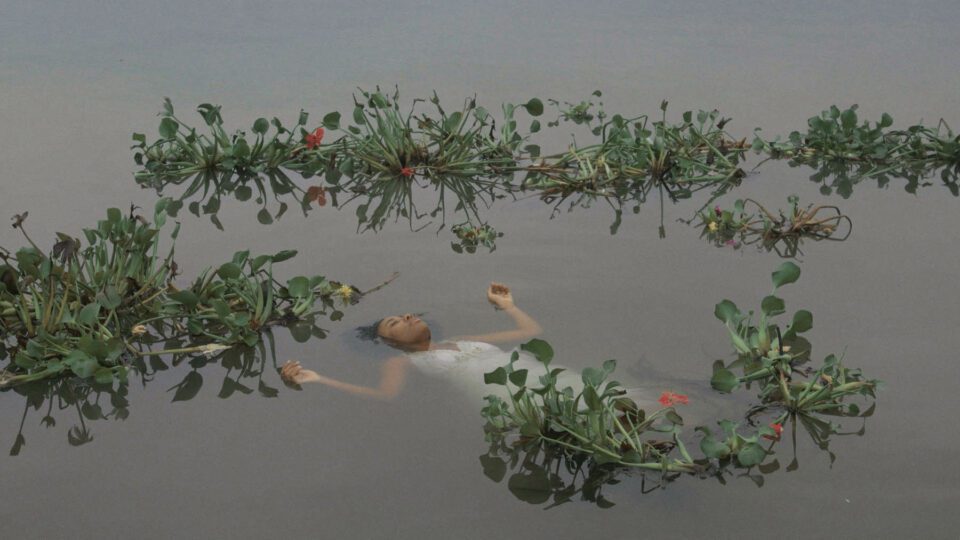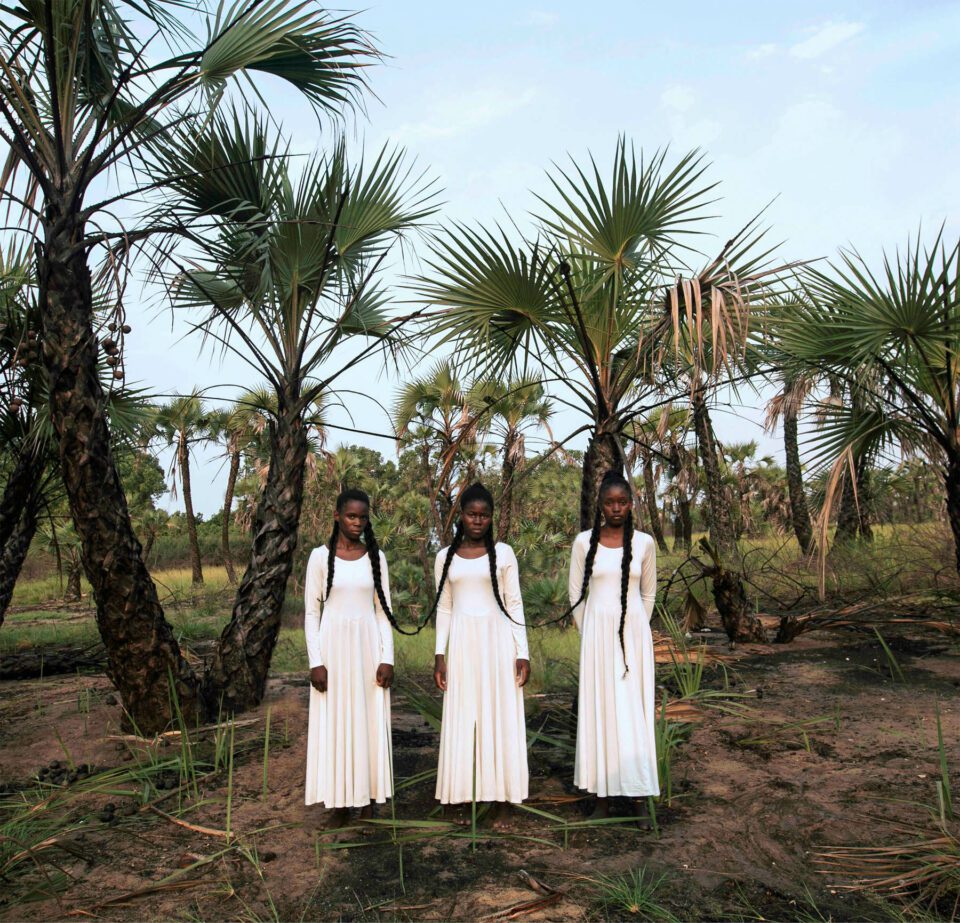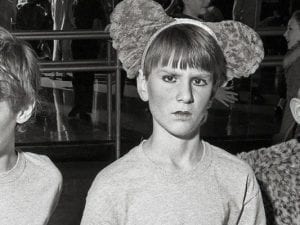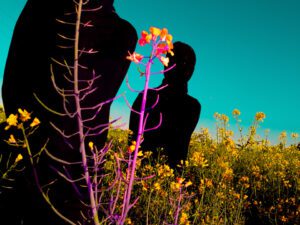In fairytales, the mirror is a recurring trope – the most ob- vious example being Snow White (originally published as part of Grimm’s Fairy Tales in 1812). For the protagonist of Mónica de Miranda’s (b. 1976) film The Island, currently on display at Autograph ABP, London, the mirror alludes to the image preserved in western folklore that serves to identify the “fairest” maiden in the land. “It’s about beauty and being allowed to be beautiful,” says the Portuguese-Angolan artist. Here, more than a tool for observation, the mirror is constructive – a portal to a post-colonial self-realisation. “The character goes through a journey of transformation, reclaiming her space as a female body within the landscape and in public.”
Non-linear in narrative, The Island features a series of scenes over the course of 37 minutes, in which we see an array of characters – mostly female – engage in poetic conversations, wander across the island, or undertake symbolic acts using props or costume – setting fire to a pile of period frocks, for example, as though to turn the past to embers and, phoenix-like, begin anew. “The characters connect to different memories and moments, but also to archetypes in our mind,” de Miranda explains. Past, present and future collide in changing configurations, which consider different relationships or aspects of Portuguese Afrodiasporic identity through dialogue: a couple, a mother and daughter, two young women dressed in the berets and combat trousers of 1960s African liberation revolutionaries. The heroine crosses the screen astride a horse, dressed in men’s riding attire, re-channelling the power of male figures seen in western canonical literature and painting. As the title suggests, the film is set on an island, but this does not align with a fixed geo- graphical location; it is a separate, metaphorical space which is recognised for “refuge and escape”, where historical narratives can be worked through, and new possibilities envisioned.

The isolation of the setting is also indicative of societal circumstances at the time of its making – Portugal, and much of the world, was in lockdown. “Coming from the diaspora, I have all these memories passed down from my mother and grandmother about the curfews they experienced during the Portuguese Colonial War in Angola (1961-1974),” says de Miranda. “For the first time, I was experiencing what it felt like to lose my freedom, but that seemed somehow connected to another place and to a completely different story. These biographical elements came into my imagination, together with my research practice.” Combining film, photography and sound, de Miranda’s work is informed by eco-feminism, taking inspiration from the environmentalist Dr. Vandana Shiva (b.1952), who argues that a revolution in farming, grounded in biodiversity, holds the key to emancipation for women and food security for all. “Agricultural systems which are women-centred and Earth-centred are also more productive,” Shiva wrote in her 2004 essay, Empowering Women.
The artist was commissioned by Autograph to make the film, which is shown in the form of an installation, along- side still photography – fragmented landscapes from previous bodies of work, in addition to beautifully composed, formal portraits made during the course of production. One stand-out picture shows a woman in a white dress, gazing out across a former quarry that has been redeveloped as a lake. The muted tones, misty light and watery setting give the image a mythical, redemptive feel. The work on show is part of a project called Amplify – Stranger in the Village: Afro European Matters, for which de Miranda and two other artists, Jeannette Ehlers (b. 1973) and Sasha Huber (b. 1975), were invited to create new pieces around the history of Afrodiasporic communities in Europe. The title references novelist James Baldwin’s (1924-1987) painful experience of being the only Black person in a small village in the Swiss Alps in 1951. “When we talk about Black experience, we tend to forget the rest of Europe,” says Dr Mark Sealy, Director of Autograph ABP. “African American culture is very strong here but I’m also mindful of Afro Berlin, Afro London, Afro Lisbon, Afro Finland, Afro Sweden – all these different African cosmologies.” In the mid-16th century, 10% of the population of Lisbon was Black. “This research is only very recent,” says de Miranda. “We don’t really have an Afro Portuguese identity. It’s a different dynamic to other countries in Europe.”

Located in Shoreditch, Autograph’s mission is “to champion the work of artists who use photography and film to high- light questions of race, representation, human rights and social justice.” It has been running since 1988, when it was set up by the Lagos-born artist Rotimi Fani-Kayode (1955-1989) as the Association of Black Photographers. The 1960s through to the 1980s were decades shaped by the liberation of colonised countries in Africa and Latin America, the Civil Rights Movement in America and racial struggles in Britain, where riots took place – notably in Brixton, South London, and Handsworth, North Birmingham – in 1981, sparked by discrimination and violence against Black communities at the hands of the police. Concurrently, there was a flourishing sense of creativity developing amongst young Black artists. The Black Arts Movement in America – sometimes referred to as the Second Renaissance following the Harlem Renaissance (1920s-1930s) – gave rise to a network of new grassroots galleries and organisations supporting artists of colour, whilst 1982 saw the founding of the British Black Arts Movement at a conference in Wolverhampton organised by the West Midlands-based Blk Art Group – whose members included Lubaina Himid (b. 1954), Keith Piper (b. 1960) and Donald Rodney (1961-1998), amongst others. “Post-Brixton Riots, there was a sense that Black photographers in par- ticular needed a platform to tell their stories because there was just so much negative press,” remembers Mark Sealy, who joined Autograph as Director in 1991. “We talk about the ‘hostile environment’ now, but the 1960s through to the 1980s were really hostile. The Greater London Council, which had supported ethnic minority artists, had been closed down, and there was a generation of kids coming out of colleges, picking up cameras, and they needed somewhere to articulate their experiences. Autograph was part of that.”

Originally established as an agency like Magnum Photos, Autograph has transformed into an institution. “It has done this by slowly working through these various cultural turns,” Sealy explains. “Some of those moments have been favourable and Autograph has been seen as something to invest in by trusts and foundations and state agencies.” In 2007, this allowed Autograph and INIVA (Institute of International Visual Arts) to open Rivington Place, a purpose-built arts centre designed by David Adjaye, which has hosted exhibitions by Hew Locke (b. 1959), Zanele Muholi (b. 1972), Sunil Gupta (b. 1953) and other leading contemporary artists.
Autograph has always been evolving. In addition to staging exhibitions and events, the organisation runs research projects, an education programme, holds a collection and commissions new work – as in the case of The Island. Sealy is within their staff currently collaborating with London College of Communication, University of the Arts, helping them develop strategies or greater cultural inclusion by establishing bursaries or revising the curriculum to ensure it has balance and includes material that feels relevant to all students. It’s also important, he stresses, that there are commissions for graduates to provide a much-needed industry leg up when they leave college or university. Audience development is another important strand of Autograph’s work. “There are a lot of people who, when they cross the threshold of somewhere like this, they think, wow, I didn’t realise I could have this kind of conversation. There’s a sense, especially with younger audiences, that once they’re there, you can really engage them.”
In its immediacy, photography, Sealy believes, is a particularly resonant medium for conveying the rich diversity of perspectives that make up societies today. “Photography can close gaps, bringing people closer together. You can see yourself in images, identify with the stories.” This is as important in today’s world, riven with fault lines, as it has ever been. “We live in such complicated times. If there’s one thing the last few years have taught us, it’s that human rights and racial politics are precarious entities. Rights are often thought of as being on the margins – refugee rights, workers’ rights, Black subjects’ rights, queer subjects’ rights, women’s rights … When a society sees itself as getting progressively wealthy, they become less amplified. However, it’s important to keep pushing for human rights and social justice – it’s not a quick fix, it’s about the state taking responsibility for its subjects.”

Accelerated by the Black Lives Matter movement, museums and galleries seem to be restructuring their mission statement to something more like Autograph ABP’s ethos – taking steps towards addressing inclusivity within their staff employment and output. There have been a number of major group shows programmed recently, for example, that focus on artists from the African continent and diaspora such
as Ekow Eshun’s In the Black Fantastic, at Hayward Gallery, Southbank Centre, Sealy’s own African Cosmologies: Photography, Time and The Other at FotoFest 2020 or Antwaun Sargent’s The New Black Vanguard atAperture Foundation in 2019 to name a few.
“A window has opened, for sure,” says Sealy. “I think social media has had a big impact. There’s a sense that certain art- ists have been overlooked and institutions are responding. But we don’t just need appointments of gallery directors or new acquisitions, we need real pathways for people who are graduating to come through. Let’s hope it becomes part of the everyday.” Art is how we imagine other ways of being. An industry that reflects society isn’t only an ethical imperative, it gives rise to better art, more ways to think about the future.
As Mónica de Miranda notes, the histories exposed in The Island have legacies that continue to permeate within today’s world – and with catastrophic implications for the human and non-human. She expands: “One of the fundamental problems in our ecological crisis is that we’re still tied to a colonial way of acting in how we exploit nature, and this has brought us to a place where we are all losing our freedom.” What we need are mirrors that reflect collectively the myriad of stories and experiences from individuals across the world.
Words: Rachel Segal Hamilton
Mónica de Miranda: The Island | Autograph APB, London Until 22 October | autograph.org.uk
Image Credits:
1. Mónica de Miranda, Whistle for the wind from The Island series (2022). Courtesy of the artist.
2. Mónica de Miranda, Mother and daughter from The Island series (2022). Courtesy of the artist.
3. Mónica de Miranda, Botanic gardens from Arquipélago series ( 2014).
4. Mónica de Miranda, Path to the Stars video still, HD video, sound, 34 min. 41 sec. (2022) Courtesy of the artist.
5. Mónica de Miranda, Three Sisters from Path to the Stars series (2022). Courtesy of the artist.





